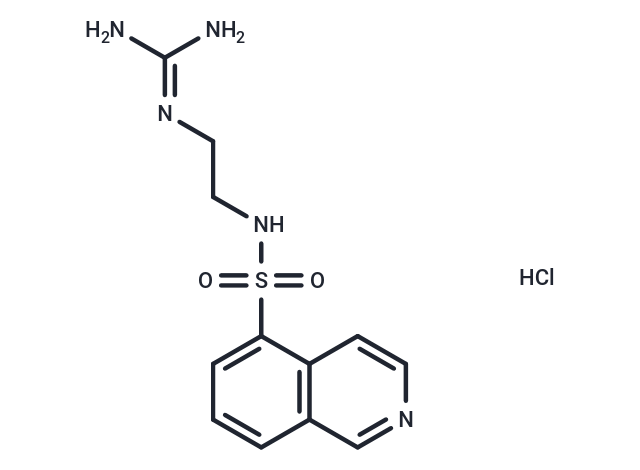Shopping Cart
- Remove All
 Your shopping cart is currently empty
Your shopping cart is currently empty

HA-1004 dihydrochloride is an inhibitor of PKA, PKC, cGKI, MYLK, and calcium channel protein

| Pack Size | Price | Availability | Quantity |
|---|---|---|---|
| 1 mg | $370 | 6-8 weeks |
| Description | HA-1004 dihydrochloride is an inhibitor of PKA, PKC, cGKI, MYLK, and calcium channel protein |
| In vivo | HA-1004, was shown to be a potent inhibitor of two cyclic nucleotide-dependent protein kinases, cyclic GMP-dependent protein kinase and cyclic AMP-dependent protein kinase and the Ki values were 1.4 and 2.3 microM, respectively.?HA-1004 relaxed rabbit aortic strips contracted by various agonists and with similar ED50 values.?Phenotolamine, propranolol and atropine did not affect this HA-1004-induced relaxation, thereby suggesting that this compound does not act through these membrane receptor associated mechanisms.?HA-1004 shifted the dose-response curve for CaCl2 to the right in a competitive manner in depolarized rabbit renal arterial strips.?This compound also relaxed the A-23187 and phenylephrine-induced contractions elicited in Ca++-free solution.?HA-1004 exerts its action at the intracellular or submembranal level.?This vasodilator has little effect on actomyosin adenosine triphosphatase and Ca++-calmodulin-dependent myosin light chain kinase.?Studies using its derivatives with various lengths of alkyl chain (C0-C6) indicated that the potencies of these compounds, as vasorelaxants, correlated well with their potential to inhibit cyclic nucleotide-dependent protein kinase.?HA-1004 should be a useful tool for investigating in smooth muscle, regulatory mechanism(s) by second messengers, cyclic AMP and cyclic GMP[1]. |
| Molecular Weight | 329.81 |
| Formula | C12H16ClN5O2S |
| Cas No. | 92564-34-6 |
| Smiles | C1=CC2=C(C=CN=C2)C(=C1)S(=O)(=O)NCCN=C(N)N.Cl |
| Relative Density. | no data available |
| Storage | Powder: -20°C for 3 years | In solvent: -80°C for 1 year | Shipping with blue ice. |

Copyright © 2015-2024 TargetMol Chemicals Inc. All Rights Reserved.